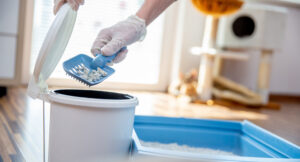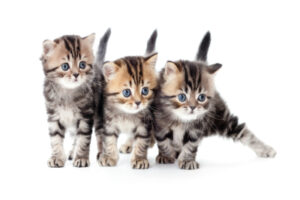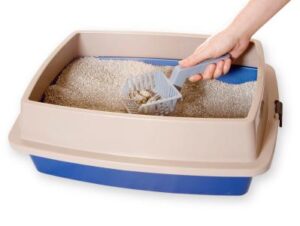There are different types of cat litter that you can choose from if you have a kitty. Clumping cat litter makes the wet refuse turn into solidified materials. Also, clumping kitty litter may contain sodium bentonite or natural clay that forms hard pellets when dried up. Notably, the sodium bentonite used in the box is responsible for binding moisture and cat litter into solid balls. When the cat feces are dry, it is easier to dispose of since they are scoopable.
Therefore, if you are aiming at making the kitty litter last longer before getting rid of it, opt for the kind that clumps. Keep in mind that leaving cat litter undisposed can harbor bacteria and parasites.
Table of Contents
Preparing to Dispose of Clumping Cat Litter

– Buy heavy-duty bags
When you are thinking of getting rid of clumping cat litter, you should start by buying paper bags for disposal. Thick and heavy bags will serve the purpose since you want to avoid spillage of the waste from a torn bag. Additionally, clumping cat litter is pretty dense, so they can easily tear a weak trash bag.
However, if you don’t have a thick one, put two thin papers together to provide extra support for the dense clumps. Also, if possible, let the trash bag be specifically for the kitty litter to avoid opening it.
– Properly put the bag in the trash bin
After you have purchased your bags, place them carefully in the cat litter can. Notably, you don’t want to hold the trash bag when you are emptying the clumping kitty litter since some pieces might fall. Hence, put the bag before scooping the cat waste to make it easy when you are pouring it. Also, the trash bin will give the heavy-duty bag structural support making it open wide and steady. Therefore, you don’t have to worry about unnecessary spills on the floor that might make you disgusted by the kitty litter.

Disposing of Cat Litter Procedure

1. Scoop the clumps
Scooping the cat litter is easy since urine and feces clump into solid chunks. Also, the poop gets coated hence it does not stick on the scooper as you lift the waste. Therefore, remove the cat waste out of the litter box using your cat litter scoop. Avoid shaking the scooper as you as picking the clumps since it will stir up more dust in the room. Additionally, carefully hold the kitty litter scoop to prevent pieces of feces from falling on the surface as you are heading to the trash bin. If you are wondering where you can get a cat litter scoop, find it in a pet house, big-box stores, or online.
2. Put the clumps into a trash bag
After scooping the kitty litter, the next thing you do is putting it in a trash bag. Transfer the waste to a cat trash bin that should be wide open. Also, you can hold the paper with one hand and pour the refuse in the cat scoop using the other hand. Turn the handle of the scooper until the kitty waste is at the bottom of the trash bag. Notably, ensure that all the clumps get inside the bag and none is left in the scooper. Remember, properly disposing of the kitty clumps is essential in making sure that there is no odor in your house.

3. Tie a knot on the litter bag
Inserting the clumps in the trash bag is not enough. Disposing of the clumping cat litter includes eliminating the awful smell produced by the waste. Therefore, it is crucial to tie a knot and safely hide the waste in the bag. Hence, all the odor is confined inside and it does not get out in the house. Tying the plastic bag using a knot or a zip tie ensures that it is properly sealed and ready for disposal. Hence, the knot should be tight so that the kitty litter remains contained and unexposed.
4. Dispose of the trash paper
Remove the bag or trash can with clumping cat litter outside instead of letting it stay inside and create an odor. Keep the lid closed since when kept open it can cause contaminations due to the germs produced. Also, when the trash can is far, the immediate home environment is kept safe and healthy. During the garbage day, remove your trash bag from the bin and throw it into the outdoor bin. Note that ingested clumping cat litter swells in the stomach and intestines. Thus, ensure that it is collected and out of reach from children and animals.

5. Get rid of clumping cat litter with biodegradable
Besides letting a company collect the clumping kitty waste, you can use a biodegradable cat litter to help with composing. Some consist of ingredients such as grains, corn wood shavings, or wheat. Notably, using a biodegradable clumping cat litter will allow you to compost the waste yourself. Also, before burring the clumps, check with the local law to make sure that it is authorized. If you are not permitted to compost the litter, find a program in your community that will assist with getting rid of the waste.
6. Cleaning after disposing of clumping cat litter
When you are removing the cat waste from a litter box, some of the clumps might stick. To remove the remaining feces from the scooper, you should rinse it under clean water. Also, consider using soap and a cleaning cloth if the waste remains attached to the cat scoop. Keep in mind that washing it ensures no bacteria is spreading in the house. Notably, before storing the scooper in a zipper bag or somewhere safe, disinfect or bleach to kill available germs. Additionally, after disposing of the clumping cat litter, whether you used gloves or not, wash your hand for hygienic matters.
7. Fill up the kitty litter box
After disposing of the clumping cat litter, it is essential to replace the necessary materials that you scooped out. Add enough sodium bentonite or natural to assist in clumping the cat waste. Always remember to dispose of the clumping cat litter every four to six weeks. Note that you do not want any bacteria to build up for the safety of the people living in your house and pets around. Also, if you have multiple cats, empty the clumping cat litter box as many times as possible and refill it. When you dispose of the kitty clumping litter, wash the box or disinfect it.


